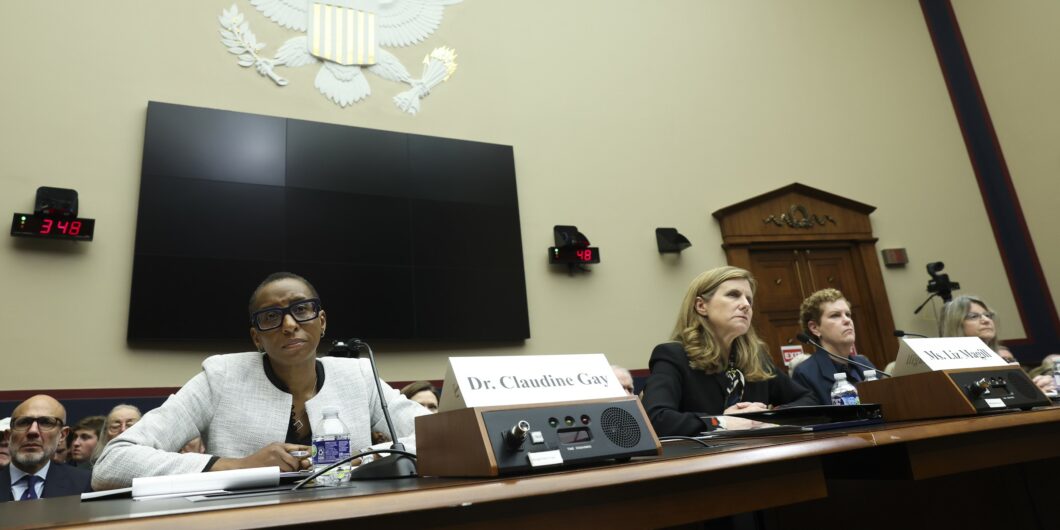Dissolve the Universities?
About three weeks ago, I went to the Institute of Economic Affairs Christmas party in London. The end-of-year bash fell a couple of days after sundry US university presidents appeared before Congress. For banal busyness reasons—London does produce its own news—I hadn’t seen it.
Various party people tried to convey to me the calamitous nature and effect. I’m afraid I struggled to believe them. Nothing could be that bad, I thought, especially given US Congresscritters are far politer than UK Commons MPs or—to make the contrast even starker—Australia’s by turns amusing and spittle-flecked parliamentarians.
When I did finally see it—24 hours later—it seemed I was watching Australia’s Senate Estimates, except the accents were all wrong. An attack-dog politician in the Australian style was going after three university vice-chancellors (what we call university presidents) who were making an absolute meal of their testimony. Kids these days say “cringy” or “cringeworthy,” but I prefer my mother’s phrase: toe-curlingly embarrassing.
I started to wonder if it were made so ruinous because we could all see their faces. There was a moment there, with the Penn woman’s awful gurning—her mouth twisting into a smile—where I wanted to pick up a corner of the carpet and crawl underneath. It was almost unwatchable. I concluded the visuals were making it worse—gurning is something done for shits and giggles at parish fairs in the North of England—and hunted down a BBC Radio 4 report on the controversy which, of necessity, was audio-only.
I was wrong. Even without video, it’s just as awful.
Since then, I haven’t been able to get it out of my mind’s eye. I don’t think there’s any coming back from that. This is how an institution’s social licence is lost. It reminded me of the infamous big tobacco hearing where major cigarette manufacturers straight up lied to Congress about the link between smoking and cancer.
I understand and respect the people making serious and thoughtful policy suggestions designed to “fix” the Ivy League and US higher education more widely. The Foundation for Individual Rights and Expression has a useful laundry list for starters, while attorney and legal academic Glenn Reynolds has ideas that overlap with FIRE’s plus a few bonus proposals of his own. I’ve selected those two out of hundreds because they both understand that when you censor any speech, you then make yourself responsible for whatever speech you do allow. Blind Freddy can see your double standards and is often happy to hold you to them—as angry alumni and donors queuing up to lob rocks at the Ivies show.
However, respect for FIRE and Reynolds—and my belief that implementing the policies they advocate would be beneficial for Americans, so please do them for your country’s sake—does not mean they’ll “fix” your universities. The universities are like big tobacco: they’re never going to be good places full of good people, and you need to accept that. No matter how much you enjoy them, cigarettes will kill you. The universities’ number is in the process of coming up.
“How?” I hear you ask. “Harvard alone has an endowment north of fifty billion dollars.”
Well, I live in a country that once had institutions many times richer (in relative terms) than Harvard, Penn, or MIT. And in four short years—1536 to 1540—all of them had passed into history. Attempts to revive them at the highest level less than 20 years later failed. I speak, of course, of Henry VIII’s Dissolution of the Monasteries. As with the monasteries, if Harvard annoys the people of your country enough—especially your wealthy elites—then its 50-billion-dollar endowment will not save it.
By the time the sixteenth century rolled around, English religious houses of varied sorts controlled appointment to about two-fifths of all parish benefices in England, disposed about half of all ecclesiastical income, and owned a quarter of the nation’s landed wealth. When Thomas Cromwell (Henry’s enforcer; he led the so-called “visitations”) established how much money monasteries had in 1535, it turned out that, had the Abbot of Glastonbury married the Abbess of Shaftesbury, their heir would have more land than the King. Of England’s adult male population at the time—approximately half a million—one in fifty were in religious orders. With only a handful of exceptions, England’s best-educated and brightest women were all nuns.
Of course, the schoolgirl stories I was taught about England’s monastic dissolutions are at least partly true: Henry VIII was notoriously broke and never a genuine Protestant in a way, say, Martin Luther would recognise. His religious policies were often incoherent. Famously—in 1537—he founded a new monastery to pray for his wife Jane Seymour’s soul (while continuing to dissolve monasteries hither and yon). The old gag that the Church of England sprang out of a sexually profligate monarch’s jockstrap has something to it.
Whether a given monastery was held in contempt or considered a worthy institution depended on the role it had played locally. If it gave out poor relief, educated local children, participated in regional markets, and provided spiritual services, it tended to be beloved. It was inwardness, unworldliness, and failure to engage with society—while taking people’s money in tithes—that did many of them in. If you don’t share, we won’t support was a real gripe of long standing.
Locking away both human and economic capital never goes down well, and resentment was not unique to England and Wales or Reformation Europe: it arose in other civilisations with their own monastic traditions. In 843, China’s Tang Dynasty Emperor Wuzong—like Henry VIII, short of cash—dissolved his country’s Buddhist monasteries. He began by ending their tax-exempt status. Also like Henry, he probably didn’t start the process intending to extirpate all monasticism, but that’s what it became. His 845 edict is thunderous:
Buddhist monasteries daily grew higher. Men’s strength was used up in work with plaster and wood. Men’s gain was taken up in ornaments of gold and precious stones. Imperial and family relationships were forsaken for obedience to the fees of the priests. The marital relationship was opposed by the ascetic restraints. Destructive of law, injurious to mankind, nothing is worse than this way. Moreover, if one man does not plough, others feel hunger; if one woman does not tend the silkworms, others go cold. Now, in the Empire, there are monks and nuns innumerable. All depend on others to plough that they may eat, on others to raise silk that they may be clad.
It’s important to remember that the Dissolutions—while based on real grievances—utterly rent England’s social fabric. It’s not something I’d wish on any country. In one area where religious houses were loved and supported, it led to serious popular revolt: the 1536 Pilgrimage of Grace started in Yorkshire and soon spread to other Northern counties. Robert Aske, leader of the Pilgrimage, testified that “the suppression of abbeys was the greatest cause of the said insurrection,” pointing out that Northern religious houses “gave great alms to poor men and laudably served God.”
Claudine Gay, Elizabeth Magill, and Sally Kornbluth didn’t turn up trying to sell Elise Stefanik a piece of the True Cross or an ampoule of San Gennaro’s blood, but they may as well have.
There’s also evidence that English civilisation was developing different social arrangements from what had obtained previously. Many had come to believe resources expensively deployed on an unceasing round of services by men and women set apart from the world would be better spent on training people who would then serve the laity.
Wealthy people were already directing moneys towards Oxford and Cambridge, grammar schools for pupils of all ages, and the Inns of Court. The great religious houses, however, thought they were safe from this civil society shift: after all, they had their vast endowments. Typically, their eleventh- and twelfth-century founders had endowed them with both “temporal” income in the form of revenues from landed estates, and “spiritual” income in the form of tithes appropriated from parish churches under the founder’s patronage. Who cared if the local Lord had changed his mind about a nearby abbey’s value? The money, as it were, was already in hand.
When it comes to US universities and their endowments, we have been here before.
There’s another element in common, too: shared beliefs in and promotion of rank superstition. One theological point on which Henry agreed with both Thomas Cromwell and Cromwell’s intellectual influencers (Desiderius Erasmus and Luther) was that monasteries were riddled with superstitio.
Superstitio is not a nice word in either Classical or Ecclesiastical Latin. Pagan Roman critics of early Christianity called the new kid on the religious block superstitio. Unlike other Classical Latin words—as sometimes happened once the language ceased to be a spoken one—superstitio did not change its meaning. It remained shorthand for bonkers religious nonsense with emotionally incontinent roots.
In 1535, what was the substantive content of Cromwell’s superstitio as found in the monasteries? Fake relics and fake miracles—and pointless pilgrimages to see both—designed to empty credulous people’s pockets. Cromwell inveighed against superstitio from the outset: “They shall not show no relics or feigned miracles for increase of lucre.”
Claudine Gay, Elizabeth Magill, and Sally Kornbluth didn’t turn up trying to sell Elise Stefanik a piece of the True Cross or an ampoule of San Gennaro’s blood, but they may as well have. They believe things—as their testimony and behaviour both before and since shows—that are vacuous nonsense, rooted in emotionally incontinent wibble. They’ve adopted a tendentious definition of racism that blinds people to injustices against any group seen as dominant. They’ve divided the world into simplistic categories of oppressors and oppressed, of whites and people of colour, of colonisers and colonised. They’ve concluded discrimination is justified on behalf of the marginalised. They think “my truth” can be substituted for “the truth.”
Worse, much of the worst drivel was developed by female and minority authors who, sadly, have been praised far above and beyond their actual talent by people who should know better in often mortifying cases of head-patting and humouring. Like Samuel Johnson, they think “a woman’s preaching is like a dog’s walking on his hind legs. It is not done well; but you are surprised to find it done at all.” Unlike Johnson, they exalt all attempts—including risible ones—to the skies. This, in case it isn’t obvious, does not help women or minorities.
I don’t know what’s going to become of the universities—in the US or elsewhere, for that matter. We live in a world with much bigger, more powerful states and staggering wealth compared to that of Tudor England. We can afford more parasitic institutions. Henry VIII and Emperor Wuzong couldn’t. Whatever does happen will be messy.
There are also differences of degree, if not kind, within the university set: the US’s public universities come out much better in FIRE’s free speech rankings than the posh Ivies and equivalently posh non-Ivies, for example. Maybe they’ve earnt a contemporary Pilgrimage of Grace. Meanwhile, the Ivies may have commoners steal all their gold plate, rare books, and Italian altarpieces.
In 1553, Bloody Mary began a valiant but unsuccessful effort to bring about a revival in English monastic life. When she died in 1558 and was succeeded by her half-sister, Elizabeth I, the new queen offered Mary’s Westminster monks the opportunity to remain in place if they took the Oath of Supremacy and conformed to the new Book of Common Prayer. All refused and were dispersed without pensions.
There had been monasteries in England since the sixth century. In less than 20 years, the country’s monastic impulse was extinguished. Word to the universities: nothing lasts forever.



